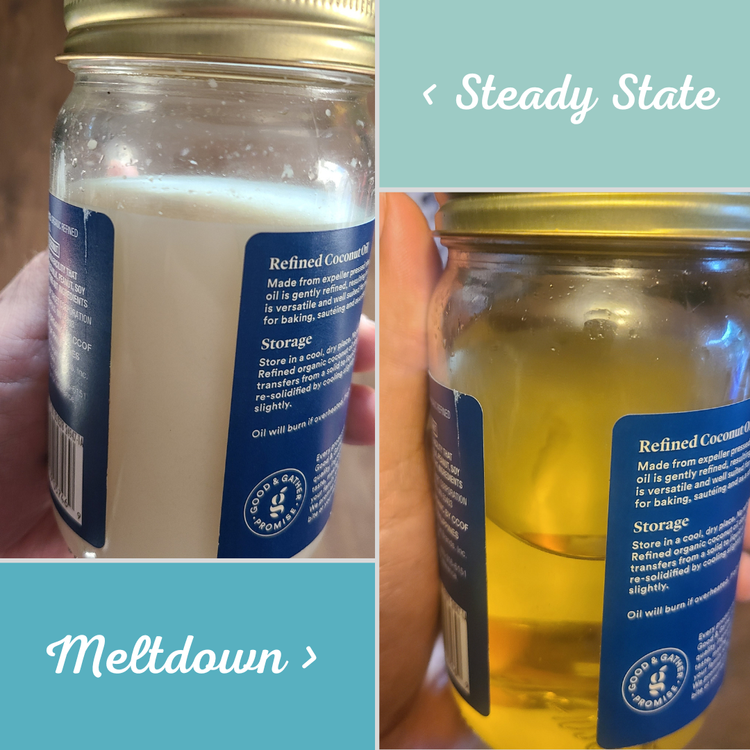Melting Down Beyond The edge
Practice Off The Mat
Vol. 1 Issue 18
Navigating your melting point isn’t always this obvious.
I’ve got some questions for you today. Where is your edge of comfort at? What happens when you cross over the edge?
<woah… Maybe I should ease into this…>
Have you ever used coconut oil for cooking?
I love it. One of the properties I find interesting is below 78 degrees Fahrenheit, the oil is solid. Above 78 degrees, it transitions to a liquified state. Much to my beard’s chagrin, I’ve discovered firsthand that it is quite combustible if you aren’t paying attention.
To quote Taylor Swift: “It's me, hi, I'm the problem, it's me”.
Yep. I am coconut oil.
You see, I don’t care for hot weather. 78 degrees Fahrenheit is pretty much the point where I start to melt. As the temperature climbs, I start to liquify. And I feel more combustible </ Noreen and the cats are nodding heads up and down in agreement>
In recent years I’ve started to become more acutely aware of this. As temperatures climb, I become more uncomfortable, my mind more erratic. My emotions become a little more combustible. I tend to be a bit grouchier.
If I’m in tune with myself, I can recognize the chain reaction starting. I can notice the edge coming closer. With that awareness comes the choice of how to engage with the discomfort. Being aware isn’t going to change the situation on its own. After all, when it’s hot and humid, its hot and humid.
However, I can think about small adjustments to feel less uncomfortable. Even if I can’t adjust my physical discomfort, the act of acknowledging that I am uncomfortable can take some of the charge out of the experience. It can help me avoid being what some may call a reactionary grumpy ass jerkface.
Mindfulness is the practice of being aware of what is happening within you and around you in the moment. It is not just about controlling or not controlling your thoughts. It is being aware of the relationship between different layers of your presence: environment, body, mind, heart, and spirit.
WITH THAT AWARENESS COMES THE ABILITY TO INTENTIONALLY CHOOSE HOW TO RESPOND INSTEAD OF REACTING WITHOUT THOUGHT.
Think about the different aspects of your present state: environment, physical body, mind, heart, spirit.
Each layer influences the other. The intersection of these layers is what contributes to how you are feeling. On one side of the edge is ease, comfort, simplicity, accessibility. On the other side is the opposite: unease, discomfort, difficulty, limitation.
Each aspect is always changing. As a result, you are always changing. The different edges are always changing. It fluctuates from moment to moment. Where the edge of resistance may show up, will also change. What felt accessible and easy before, may seem more challenging and difficult now. It is always contextual to the present moment.
I frequently describe this inquiry as a dialogue that is always happening. What do you observe? What do you notice? What adjustment do you need? What will serve you best right now?
It is not a simple conversation, given all the distractions and things that you are navigating moment to moment. It may be easier when you are in a space with ease and comfort. What about when stress or pressure increase and you cross over the edge? With all that variability, how do you stay level?
My suggestion: come back to your center. The practices of yoga and mindfulness offer a path back to your true north.
Take marked moments. Check in with yourself constantly. Let go of the things that pull at your attention. Stop what you are doing. Pause. Breathe. Realign yourself: “Where is my edge? What am I holding onto? Where is the tension right now? Can I let it go and give it space? Do I need to keep it with me for a little bit more? What will serve me right now?”
To be clear, I am not here to say what the answer should be or shouldn’t be. I am here to remind you to ask the question. To have the conversation. That is what will help you choose how to navigate the edges around you. Only you know the answer and outcome to that.
If you want some help to develop the practice or a space to practice, that I can help you with. Practicing in class, on the mat, in the studio is a way to develop the skillset. It’s a way to hone your dialogue and sharpen your inquiry.
Just remember, trust your wisdom. Listen to your voice. You know what is needed for you.
And if you suddenly find yourself erupting into flames or melting down, give yourself some grace and kindness.
Take a deep breath.
Choose what you need to cool down.
Soon enough, you’ll feel solid again.
